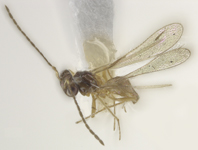Abstract
The Hylodidae genus Megaelosia Miranda-Ribeiro comprises seven frog species that inhabit the Atlantic Rainforest in Southeastern Brazil (Da Silva et al. 2018). Larvae and adults of Hylodidae are commonly associated with lotic streams (Giaretta et al. 1993; Silva-Soares et al. 2015). Tadpoles of all Megaelosia species but Megaelosia bocainensis Giaretta, Bokemann & Haddad are formally described, even though many of these descriptions are restricted to few lines and several anatomical details were overlooked (e.g., Megaelosia lutzae; Izecksohn & Gouvêa 1985). The tadpole of M. boticariana was briefly described by Giaretta & Aguiar (1998) based on a single larva with no measurements or figures. Currently, M. boticariana is only known from its type locality and São Francisco Xavier, both in São Paulo state portion of the Serra da Mantiqueira, Brazil (Muscat et al. 2020). The lack of information, coupled with the rarity of the species, reinforces the importance of taxonomic and natural history data to subside works on other fields. In this context, we present a complete redescription of the external anatomy of the tadpoles of M. boticariana and comment on their natural history.
References
Altig, R. (1970) A key to the tadpoles of the continental United States and Canada. Herpetologica, 26, 180–207.
Anganoy-Criollo, M. (2013) Tadpoles of the High-Andean Hyloxalus subpunctatus (Anura: Dendrobatidae) with description of larval variation and species distinction by larval morphology. Papéis Avulsos de Zoologia, 53, 211–224.
https://doi.org/10.1590/S0031-10492013001500001
Barrasso, D.A., Alcalde, L., Blotto, B.L. & Néstor, B.G. (2016) Description of the tadpole of Alsodes neuquensis Cei, 1976 and comparison with the sibling species A. gargola Gallardo, 1970 (Amphibia, Anura, Alsodidae). Herpetological Journal, 26, 21–31.
Da Silva, D. das N., da Rosa, F.C.B. & de Carvalho-E-Silva, A.M.P.T. (2018) Ontogeny and behavioural aspects of the tadpoles of Megaelosia goeldii (Baumann, 1912) (Amphibia, Anura, Hylodidae). Herpetology Notes, 11, 629–639.
Giaretta, A.A. & Aguiar, O. (1998) A new species of Megaelosia from the Mantiqueira range, southeastern Brazil. Journal of Herpetology, 32, 80–83.
https://doi.org/10.2307/1565483
Giaretta, A.A., Bokermann, W.C.A. & Haddad, C.F.B. (1993) A review of the genus Megaelosia (Anura: Leptodactylidae) with a description of a new species. Journal of Herpetology, 27, 276–285.
https://doi.org/10.2307/1565148
Gosner, K.L. (1960) A simplified table for staging anuran embryos and larvae with notes on identification. Herpetologica, 16, 183–190.
Grosjean, S. (2005) The choice of external morphological characters and developmental stages for tadpole-based anuran taxonomy: A case study in Rana (Sylvirana) nigrovittata (Blyth, 1855) (Amphibia, Anura, Ranidae). Contributions to Zoology, 74, 61–76.
https://doi.org/10.1163/18759866-0740102005
Izecksohn, E. & Gouvêa, E. (1985) Nova espécie de Megaelosia de Itatiaia, Estado do Rio de Janeiro. Arquivos da Universidade Federal Rural do Rio de Janeiro, 8, 17–22.
Knapp, R.A. & Morgan, J.A.T. (2006) Tadpole mouthpart depigmentation as an accurate indicator of Chytridiomycosis, an emerging disease of amphibians. Copeia, 2006, 188–197.
https://doi.org/10.1643/0045-8511(2006)6[188:TMDAAA]2.0.CO;2
Kolenc, F., Borteiro, C., Alcalde, L., Baldo, D., Cardozo, D. & Faivovich, J. (2008) Comparative larval morphology of eight species of Hypsiboas Wagler (Amphibia, Anura, Hylidae) from Argentina and Uruguay, with a review of the larvae of this genus. Zootaxa, 1927 (1), 1–66.
https://doi.org/10.11646/zootaxa.1927.1.1
Lavilla, E.O. & Scrocchi, G.J. (1986) Morfometría larval de los géneros de Telmatobiinae (Anura: Leptodactylidae) de Argentina y Chile. Physis, 44, 39–43.
Malagoli, L.R., de Sá, F.P., Canedo, C. & Haddad, C.F.B. (2020) The tadpole of Hylodes caete (Anura: Hylodidae), an endemic Atlantic rainforest Torrent frog of Brazil. Zootaxa, 4852 (5), 594–599.
https://doi.org/10.11646/zootaxa.4852.5.10
McDiarmid, R.W. & Altig, R. (1999) Body plan. Development and morphology. In: McDiarmid, R.W. & Altig, R. (Eds.), Tadpoles. The Biology of Anuran Larvae. The University of Chicago Press, Chicago, Illinois, pp. 24–51.
Muscat, E., Stuginski, D., Nunes, I., Martins, I., Augusto-Alves, G., Vittorazi, S.E., Toledo, L.F. & Moroti, M. T. (2020) Update on the geographic distribution of three poorly known frog species in the Mantiqueira mountain range. Herpetology Notes, 13, 573–577.
Nogueira-Costa, P., Almeida-Santos, P., Cruz, C.A.G. & Caramaschi, U. (2012) The giant tadpoles of Megaelosia jordanensis (Heyer, 1983). Zootaxa, 3581 (1), 86–88.
https://doi.org/10.11646/zootaxa.3581.1.4
Nuin, P.A.S. (2003) Description of the tadpole of Megaelosia goeldii (Leptodactylidae, Hylodinae) with natural history notes. Herpetological Review, 34, 27–28.
Pombal, J.P., Prado, G.M. & Canedo, C. (2003) A new species of giant torrent frog, genus Megaelosia, from the Atlantic Rain Forest of Espírito Santo, Brazil (Amphibia: Leptodactylidae). Journal of Herpetology, 37, 453–460.
https://doi.org/10.1670/220-01A
Quinzio, S.I. & Goldberg, J. (2019) Transient integumentary structures in Boana riojana (Anura, Hylidae) tadpoles. Amphibia-Reptilia, 40, 543–549.
https://doi.org/10.1163/15685381-20191226
Rot-Nikcevic, I. & Wassersug, R.J. (2004) Arrested development in Xenopus laevis tadpoles: How size constrains metamorphosis. Journal of Experimental Biology, 207, 2133–2145.
https://doi.org/10.1242/jeb.01002
Silva-Soares, T., Nogueira-Costa, P., Júnior, V.N.T.B., Weber, L.N. & Rocha, C.F.D. (2015) The larva of Crossodactylus aeneus Müller, 1924: Morphology and ecological aspects. Herpetologica, 71, 46–57.
https://doi.org/10.1655/HERPETOLOGICA-D-13-00048
Toledo, L.F., Britto, F.B., Araújo, O.G.S., Giasson, L.M.O. & Haddad, C.F.B. (2006) The occurrence of Batrachochytrium dendrobatidis in Brazil and the inclusion of 17 new cases of infection. South American Journal of Herpetology, 1, 185–191.
https://doi.org/10.2994/1808-9798(2006)1[185:TOOBDI]2.0.CO;2


